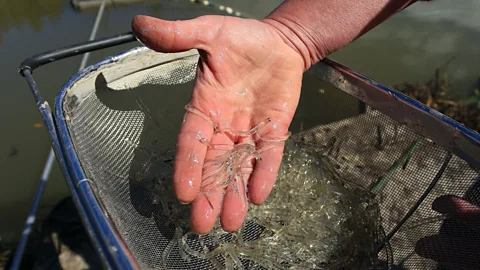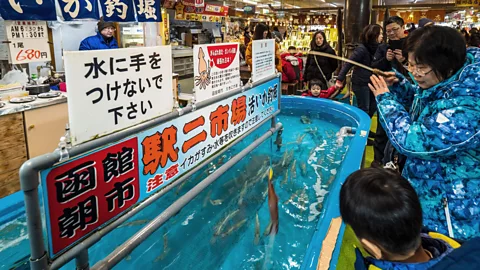The mysterious case of Japan's ‘dancing zombie squid’
 Lev Dolgachov/Alamy
Lev Dolgachov/AlamyKatsu ika odori-don came to global attention in 2010 thanks to a YouTube video that went viral. But how did this unique phenomenon come about?
Katsu ika odori-don isn’t for the faint of heart.
Loosely translated as ‘dancing squid bowl’, the controversial Japanese dish came to global attention in 2010 thanks to a YouTube video that went viral. The video depicts a headless squid perched on top of a bowl of noodles and roe. A mysterious hand appears with a teapot and pours what appears to be soy sauce onto the squid. The tentacles begin writhing wildly, granting the dish the unofficial title of ‘dancing zombie squid’.
As strange as the dish might seem, this is a contemporary take on a method of consumption in which seafood is eaten while still moving, referred to as odorigui (literally ‘dancing eating’), in Japan.
Although the squid in this case is dead, its nerve cells are activated by the sodium in the soy sauce, which triggers the cells and commands them to fire, forcing the muscles to contract. And while odorigui can be found across Japan, the origin of this unique phenomenon is a little more mysterious.
 Lev Dolgachov/Alamy
Lev Dolgachov/AlamyThe elusive practice of odorigui – which most often involves eating tiny, live fish – likely stems from fishing practices in port cities, with regional iterations on the practice. “In Shizuoka, a prefecture on central Honshu’s Pacific coast, it’s whitebait or shirasu that’s the preferred moving meal,” said Dave Lowry, a Japanese-restaurant critic and author of The Connoisseur's Guide to Sushi. “In Fukuoka, odorigui is almost synonymous with the shiro-uo, or ice goby, a tiny, eel-like fish that goes from the ocean to freshwater to spawn,” he added, explaining that the shiro-uo live in abundance around Fukuoka and are eaten alive because they start to deteriorate as soon as they die.
“If you were to ask most Japanese where they associate most with odorigui, they'd answer ‘Fukuoka’,” said John Ashburne, editor-in-chief of the blog Foodies Go Local.
Head to this port city on the northern shore of Kyushu and you’ll find a nondescript white building marked ‘Koharu’ (‘Small Spring’), a shiro-uo restaurant that is dismantled after each shiro-uo season, which runs from mid-February to the start of April. Outside is one of the few historical references to odorigui that’s the most commonly cited origin story of the practice. Here, a large display tells the so-called legend of the dish, a tale of the daimyos (feudal lords) that ruled over Japan in the Edo period 300 years ago.
“The story is that after a particularly bad flood [in Fukuoka] the local lord ordered the people to clean up – and provided a barrel of sake as a reward. The workers noticed the shiro-uo caught in what remained of the flood waters, and, sake needing something to go with it, they popped the fishes in and drank up,” Lowry said.
 Hagen Hopkins/Getty Images
Hagen Hopkins/Getty ImagesWant to try it?
To try katsu ika odori don, head to Hakodate’s Donburi alley. It’s here that you can find the sushi restaurant Ikkatei Tabiji, who first began serving the squid whole rather than preparing it in the ikizukuri style, most likely around 2010 when the viral videos started surfacing. Since then, several other restaurants in the area have begun serving odori don-style dishes to the curiosity and delight of tourists seeking bizarre eats.
Eating the tiny fish is an experience in and of itself. A large bowl arrives at the table, with many tiny fish wriggling in place, along with a raw quail egg and a bottle of vinegar. The egg and vinegar are mixed into a separate bowl, and a ladle is used to scoop the fish into the bowl with the vinegar mixture. Finally, chopsticks are used to catch the fish and eat them.
While eating live shiro-uo may well have been a precursor to the dancing squid, this still doesn’t explain how the phenomenon evolved from eating tiny fish to using larger cephalopods.
It’s likely that odorigui is a modern offshoot of a more traditional practice, ikizukuri, according to Lowry.
“Odorigui is just one piece of the bigger live pie of Japanese cuisine,” he said. “We usually think of this as ikizukuri, or ‘live style’.”
Ikizukuri translates to ‘prepared alive’ and refers to a method of consumption in which a chef prepares sashimi from a live squid, fish or shrimp (or even octopus or frog). Diners are asked to choose their selection from a tank in the restaurant and watch the chef prepares it, with the idea that the fresher the squid, the better the taste. The technique, called ike jime, is designed to use as few cuts as possible in order to minimise the suffering of the creature, whose pain creates a build-up of lactic acid that lowers meat quality.
Squid ikizukuri and katsu ika odori don have a few important differences, however. Ikizukuri prepares the squid while it’s still alive, sliced in three cuts and served in a simple sashimi style, often still twitching. The katsu ika odori don uses one cut to remove the head of the squid, which is then served a top a bed of noodles or rice. Guests are encouraged to pour on soy sauce and watch the squid ‘dance’.
 Robert Evans/Alamy
Robert Evans/AlamyBut how did such an unusual play on the delicacy see the light of day? Some people believe katsu ika odori don is inspired by a Korean dish made from live octopus, called sannakji, the heads of which are thought to be an aphrodisiac. Others, including Ashburne, postulate that odorigui and ikizukuri are both born from a desire to ostentatiously display the wealth and power of the elite.
“Odorigui might be seen as a throwback to the vulgar years of the bubble economy [a highly prosperous time in Japan, from 1985 to 1990], when money was no object – ikizukuri can involve ostentatiously large sums of money – and the show of wealth, and power, was of more import than the quality of the food,” Ashburne said.
The simplest answer, however, might be that odorigui – and that dancing zombie squid – is nothing more than a highly unusual ploy for publicity.
 Duy Phuong Nguyen/Alamy
Duy Phuong Nguyen/AlamyThe word ‘odorigui’ is a foreign one to Eric Rath, history professor at the University of Kansas. An expert in pre-modern Japanese cultural history, Rath has only encountered the term once (in a Kyoto sushi restaurant) and has found no reference to the practice in historical context.
“Given the absence of evidence for the custom, my suspicion is that odorigui is a modern gimmick to attract customers, with a history created for it in the way that many cultural practices in Japan and elsewhere are written backward,” Rath said.
Gimmick or not, the polarising ‘dancing zombie squid’ is a curious one. It’s a source of controversy to many, who claim the creature still retains a sense of feeling. And it’s a reflection of modern Japanese culture at its finest, one that honours the freshness of the ingredient above all else. This is perhaps why the phenomenon – and subsequent viral video – have become so popular. After all, who among us doesn’t revel in the simple glory that is freshly prepared food?
The Ritual of Eating is a BBC Travel series that explores interesting culinary rituals and food etiquette around the world.
more than three million BBC Travel fans by liking us on Facebook, or follow us on Twitter and Instagram.
If you liked this story, sign up for the weekly bbc.com features newsletter called "If You Only Read 6 Things This Week". A handpicked selection of stories from BBC Future, Culture, Capital and Travel, delivered to your inbox every Friday.
{"image":{"pid":""}}
